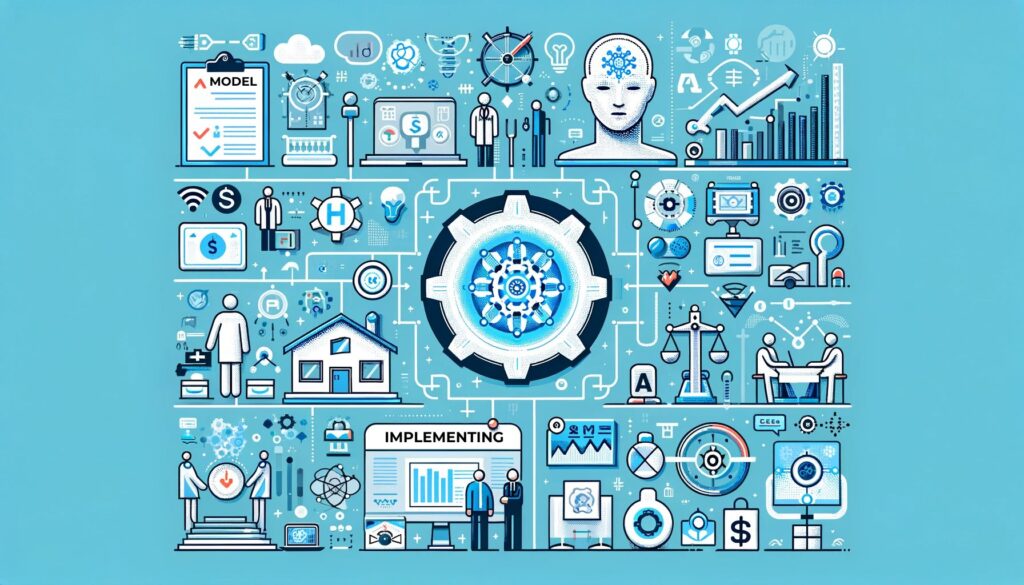In the rapidly evolving world of artificial intelligence (AI), generative AI stands out as a revolutionary force, especially in the realm of predictive modeling. This guide aims to demystify the process of building predictive models using generative AI techniques. Whether you’re a seasoned data scientist or just beginning your journey in AI, this step-by-step guide will provide you with the knowledge and tools to forecast trends, behaviors, and outcomes across various domains effectively.
Understanding Generative AI
Generative AI refers to a class of artificial intelligence that is used to create, modify, and enhance data. Unlike discriminative models that classify input data into categories, generative models can generate new data instances. These techniques have been a game-changer in fields ranging from art and music creation to more complex applications like drug discovery and market trend prediction.
At the heart of generative AI are algorithms like Generative Adversarial Networks (GANs) and Variational Autoencoders (VAEs). These models learn to mimic the distribution of the data they are trained on, enabling them to produce new data points that are indistinguishable from real data.
Fundamentals of Predictive Modeling
Predictive modeling is a statistical technique used to predict future outcomes based on historical data. It’s widely used in various industries, such as finance for stock market predictions, in healthcare for disease outbreak forecasting, and in retail for consumer behavior prediction.
Predictive modeling involves several steps, starting from understanding the problem domain, collecting and preparing data, selecting a suitable model, training the model on historical data, and finally evaluating and deploying the model.
Preparing Your Data
The foundation of any robust predictive model lies in the quality of its data. In generative AI, where the model learns to generate new data instances, the importance of starting with well-prepared data cannot be overstated. This section outlines the crucial steps in preparing your data for predictive modeling using generative AI techniques.
Understanding Your Data
Begin by gaining a comprehensive understanding of your dataset. This involves identifying the types of data you have (e.g., numeric, categorical, text, images), understanding the distribution of data points, and recognizing patterns or anomalies. Data visualization tools can be invaluable in this phase, providing insights that might not be apparent from raw data alone.
Data Cleaning
Data cleaning is the process of fixing or removing incorrect, corrupted, duplicated, or incomplete data within a dataset. When dealing with real-world data, it’s common to encounter missing values or outliers. Techniques such as imputation (filling missing values) or trimming (removing outliers) are often employed. Remember, the goal is to ensure that the data fed into your model is as accurate and representative of the real-world scenario as possible.
Data Transformation
This step involves transforming raw data into a format that can be easily and effectively used by your AI models. Key processes in data transformation include:
- Normalization and Standardization: This involves scaling numerical data to a standard range or distribution. Normalization typically means scaling data to a range of 0 to 1, while standardization involves transforming data to have a mean of 0 and a standard deviation of 1.
- Encoding Categorical Data: Many machine learning models, especially those based on neural networks, require input to be numerical. If your data includes categorical data (like ‘red’, ‘blue’, ‘green’), you need to encode it into numeric form, using techniques like one-hot encoding or label encoding.
- Feature Engineering: This is the process of creating new features from existing data to improve the performance of the model. For instance, you could derive the ‘day of the week’ from a ‘date’ field to see if it impacts the predictive model’s outcome.
Data Augmentation
In generative AI, especially when dealing with limited datasets, data augmentation can be a powerful technique. It involves artificially augmenting or increasing the amount of data by adding slightly modified copies of existing data or newly created synthetic data from existing data. For instance, in image processing, augmentation techniques can include rotations, zooming in/out, flipping, etc.
Splitting Your Data
Finally, split your data into training, validation, and test sets. The training set is used to train the model, the validation set to tune the parameters, and the test set to evaluate the model’s performance. A common split ratio is 70% training, 15% validation, and 15% test, but this can vary depending on the size and specifics of your dataset.
Preparing your data effectively is a crucial step in building a predictive model using generative AI. Clean, well-prepared data leads to more accurate and reliable models, which is essential for any AI-driven decision-making process.
Choosing the Right Generative AI Model
Selecting the appropriate generative AI model is a crucial step in the journey of building a predictive model. The choice of the model significantly influences the success of your project, as each model type has its strengths and is suited for different kinds of data and tasks. This section guides you through the process of choosing the right generative AI model for your predictive modeling needs.
Understanding Different Generative Models
Before selecting a model, it’s important to understand the various types of generative models available:
- Generative Adversarial Networks (GANs): GANs consist of two neural networks, the generator and the discriminator, which are trained simultaneously. The generator creates data instances, while the discriminator evaluates them. GANs are especially renowned for their ability to generate high-quality, realistic images but are also used for text, audio, and other data types.
- Variational Autoencoders (VAEs): VAEs are good at learning complex data distributions. They are used to generate new data points by encoding inputs into a latent space and then decoding from this space. VAEs are effective for tasks where you need to model the underlying probability distribution of your data.
- Autoregressive Models: These models, such as the Transformer architecture seen in models like GPT (Generative Pretrained Transformer), predict future data points based on past data. They are particularly effective in generating coherent and contextually relevant text.
Factors to Consider When Choosing a Model

When deciding on a generative AI model, consider the following factors:
- Type of Data: The nature of your data is a primary consideration. For instance, GANs might be more suitable for high-resolution image generation, while autoregressive models excel in text generation.
- Quality vs. Quantity of Data: Some models require large datasets to perform well, while others can work with smaller datasets but might produce less detailed outputs.
- Computational Resources: Generative models, especially GANs, can be computationally intensive. Assess the available computational resources, including GPU power, as this might limit your choice of models.
- Specific Use Case: Consider the end goal of your predictive model. For instance, if you need a model that not only generates data but also needs to understand sequence and context, an autoregressive model would be more suitable.
- Expertise and Community Support: Some models might require more expertise to implement and tune. Also, consider models with strong community support, as this can provide access to pre-trained models and troubleshooting advice.
Experimentation and Prototyping
Once you have a shortlist of potential models, the next step is experimentation. Prototyping with different models on a subset of your data can give you insights into their performance and suitability for your specific task. Utilize metrics relevant to your data type (like FID scores for image data in GANs) to evaluate model performance.
Choosing the right generative AI model is a nuanced decision that depends on your specific data, resources, and objectives. Understanding the strengths and limitations of different models, along with careful consideration of your project requirements, will guide you to make an informed choice, setting a strong foundation for your predictive modeling project.
Designing Your Predictive Model – A Step-by-Step Guide
Designing a predictive model using generative AI involves a series of structured steps, from understanding the project objective to fine-tuning the model architecture. This step-by-step guide will walk you through the essential stages of model design.
Step 1: Define the Project Objective
- Identify the Goal: Clearly define what you want your predictive model to achieve. Is it to generate new data, predict future trends, or something else?
- Understand the Data: Align your goal with the data you have. The nature of the data often dictates the type of model and features you’ll need.
Step 2: Feature Selection and Engineering
- Identify Key Features: Choose the variables most likely to influence the outcome. Use statistical methods and domain expertise for this.
- Create New Features: Engineer new features that might improve model performance. This could include combining existing features, extracting parts of the data, or transforming variables.
Step 3: Choose the Model Architecture
- Review Model Options: Based on your data type (e.g., images, text, numerical) and objective, select a suitable generative AI model architecture (like CNNs for images, RNNs for time series).
- Prototype with Simplicity: Start with a basic version of the model to establish a performance baseline.
Step 4: Data Splitting
- Divide the Dataset: Split your data into training, validation, and test sets. A typical ratio is 70% training, 15% validation, and 15% test.
- Ensure Diversity: Ensure that each data split represents the overall distribution of the data.
Step 5: Hyperparameter Setting
- Initial Selection: Choose initial values for hyperparameters like learning rate, batch size, and number of epochs.
- Tuning: Use techniques like grid search or random search to fine-tune these hyperparameters for optimal performance.
Step 6: Implement Regularization Techniques
- Choose Techniques: Decide on regularization methods like dropout, L1/L2 regularization, or early stopping to prevent overfitting.
- Apply to Model: Integrate these techniques into your model to enhance its generalization ability.
Step 7: Iterative Prototyping and Refinement
- Build and Test: Construct the model and test its performance on the validation set.
- Iterate: Based on the results, iteratively refine the model by adjusting features, architecture, and hyperparameters.
Step 8: Model Evaluation
- Test Set Evaluation: After achieving satisfactory performance on the validation set, evaluate the model on the test set to gauge its real-world applicability.
- Performance Metrics: Use appropriate metrics (like accuracy, precision, F1 score) to assess the model’s effectiveness.
The process of designing a predictive model using generative AI techniques is iterative and requires careful consideration at each step. By following this step-by-step guide, you can systematically build a model that is well-tuned to your data and project objectives, leading to more reliable and effective predictive outcomes.
Implementing a predictive model using generative AI techniques in Python involves a series of steps, including setting up your environment, preparing your data, selecting and building your model, training, and evaluating it. Below is a general guide on how you can go about this. For the sake of this example, let’s assume you’re building a model using a Generative Adversarial Network (GAN) for image generation, a common application of generative AI.
Step 1: Setting Up Your Environment
- Install Python: Ensure you have Python installed on your system. You can download it from python.org.
- Set Up a Virtual Environment (Optional but Recommended):
python -m venv myenv
source myenv/bin/activate # On Windows use `myenv\Scripts\activate`- Install Required Libraries:
- TensorFlow: For building and training the model.
- NumPy: For numerical computations.
- Matplotlib: For plotting and visualizations.
- OpenCV or PIL: For image processing (if you’re working with images).
pip install tensorflow numpy matplotlib opencv-pythonStep 2: Data Preparation
- Load Your Dataset: Load the data you’ll be training your model on. For images, this might involve loading the images from a directory.
- Preprocess Your Data:
- Resize images to a uniform size.
- Normalize pixel values.
- Split data into training and testing sets.
- Create Data Loaders: Use TensorFlow’s
ImageDataGeneratoror a similar utility to create data loaders that will feed data into the model during training.
Step 3: Building the GAN
- Create the Generator:
- This is the part of the GAN that generates new data instances.
- Use TensorFlow’s Sequential API to build a generator network.
- Create the Discriminator:
- This part of the GAN distinguishes between real and generated data.
- Build a discriminator network also using the Sequential API.
- Compile the GAN:
- Define the loss functions and optimizers for both the generator and discriminator.
- Compile the model.
Step 4: Training the Model
- Train the Model:
- This involves feeding data to the GAN, letting it generate data, and then training the discriminator to differentiate between real and generated data.
- Set the number of epochs and batch size.
- Save checkpoints if necessary.
- Monitor Performance:
- Track the loss of the generator and discriminator.
- Optionally visualize the generated images after certain intervals to see how your model is performing.
Step 5: Evaluating the Model
- Use Test Data:
- Evaluate the model using the test set.
- Observe how well the generator creates new data instances.
- Fine-Tuning:
- Based on the model’s performance, you might need to go back and adjust model parameters, add layers, or change the architecture.
Example Code Snippet
Here’s a very basic snippet to give you an idea of how you might set up the GAN (Note: This is a simplified example and may need modifications based on your specific use case):
import tensorflow as tf
from tensorflow.keras.layers import Dense, Reshape, Flatten
from tensorflow.keras.models import Sequential
# Example Generator
def build_generator():
model = Sequential([
Dense(256, activation='relu', input_dim=100),
Reshape((16, 16, 1)),
# Additional layers here
Dense(2, activation='tanh') # Adjust output layer as per your needs
])
return model
# Example Discriminator
def build_discriminator():
model = Sequential([
Flatten(input_shape=(28, 28)),
Dense(512, activation='relu'),
# Additional layers here
Dense(1, activation='sigmoid')
])
return model
# Building the GAN
generator = build_generator()
discriminator = build_discriminator()
This is a basic overview of how you can implement a generative AI model in Python. The actual implementation will depend on your specific project requirements and data. It’s also highly recommended to refer to TensorFlow’s documentation and various online resources for more detailed guidance and advanced techniques.
Training the Model

Training a generative AI model, particularly a complex one like a Generative Adversarial Network (GAN), is a nuanced process. This section will guide you through the steps of training your model, including setting up the training loop, monitoring progress, and adjusting parameters for optimal performance.
Step 1: Initialize Training Parameters
- Set Epochs and Batch Size: Decide on the number of epochs (complete passes through the entire dataset) and the batch size (number of samples processed before the model is updated).
- Learning Rate: Choose an initial learning rate. This might require tuning as training progresses.
Step 2: Preparing the Training Loop
- Define Loss Functions: For GANs, this typically involves a loss function for the generator and another for the discriminator.
- Set Up Optimizers: Choose optimizers for both the generator and discriminator. Adam or SGD (Stochastic Gradient Descent) are common choices.
Step 3: Training Loop
- For Each Epoch: Iterate over the dataset in batches.
- For Each Batch:
- Update the Discriminator: Train the discriminator on both real and generated (fake) data. The goal is to correctly classify real data as real and fake data as fake.
- Generate Fake Data: Use the generator to create new data samples.
- Update the Generator: Train the generator to fool the discriminator. The generator’s goal is to get the discriminator to classify the fake data as real.
Step 4: Monitoring Training Progress
- Track Losses: Record the generator and discriminator losses at each step or epoch.
- Visualize Outputs: Periodically generate and visualize outputs (e.g., images) from the generator to monitor its progress.
- Adjust Learning Rates if Necessary: Based on the progression of training, you may need to adjust learning rates or other hyperparameters.
Step 5: Handling Common Training Challenges
- Mode Collapse: In GANs, this happens when the generator starts producing the same output (or very similar outputs) for different inputs. To combat this, try using different architectures, loss functions, or introducing noise to inputs.
- Vanishing Gradients: This can occur when the discriminator gets too good, making it hard for the generator to improve. Techniques to mitigate this include using softer labels or label smoothing, and tweaking the architecture.
Step 6: Saving and Evaluating the Model
- Save Checkpoints: Throughout training, save checkpoints of your model so you can resume training or revert to a previous state if necessary.
- Evaluate Model Performance: Use qualitative measures (like visual inspection of generated images) and quantitative measures (like Inception Score or Fréchet Inception Distance for images) to evaluate the performance of your model.
Step 7: Iterative Improvement
- Refine and Repeat: Training generative models is often iterative. Based on your evaluations, you might go back and adjust your model architecture, reinitialize training parameters, or try different training strategies.
Training a generative AI model is an iterative and complex process that requires careful monitoring and adjustment. By methodically following these steps and being mindful of common challenges, you can effectively train your model to generate high-quality, varied outputs that meet your project goals. Remember, patience and experimentation are key in the training phase of developing generative AI models.
Implementing the training of a generative AI model in Python involves setting up a training loop, where you will iteratively train and update your model. Let’s continue with the example of a Generative Adversarial Network (GAN) for image generation. We’ll assume that you’ve already defined your generator and discriminator models as described in the previous steps.
Step 1: Define Loss Functions and Optimizers
First, import the necessary libraries and define the loss functions and optimizers for both the generator and discriminator.
import tensorflow as tf
# Loss function for GANs is usually Binary Crossentropy
cross_entropy = tf.keras.losses.BinaryCrossentropy(from_logits=True)
def discriminator_loss(real_output, fake_output):
real_loss = cross_entropy(tf.ones_like(real_output), real_output)
fake_loss = cross_entropy(tf.zeros_like(fake_output), fake_output)
total_loss = real_loss + fake_loss
return total_loss
def generator_loss(fake_output):
return cross_entropy(tf.ones_like(fake_output), fake_output)
# Optimizers
generator_optimizer = tf.keras.optimizers.Adam(1e-4)
discriminator_optimizer = tf.keras.optimizers.Adam(1e-4)
Step 2: Set Up Training Loop
Here, you’ll define the training loop. TensorFlow’s @tf.function decorator can be used to make the training loop run faster.
@tf.function
def train_step(images):
noise = tf.random.normal([BATCH_SIZE, noise_dim])
with tf.GradientTape() as gen_tape, tf.GradientTape() as disc_tape:
generated_images = generator(noise, training=True)
real_output = discriminator(images, training=True)
fake_output = discriminator(generated_images, training=True)
gen_loss = generator_loss(fake_output)
disc_loss = discriminator_loss(real_output, fake_output)
gradients_of_generator = gen_tape.gradient(gen_loss, generator.trainable_variables)
gradients_of_discriminator = disc_tape.gradient(disc_loss, discriminator.trainable_variables)
generator_optimizer.apply_gradients(zip(gradients_of_generator, generator.trainable_variables))
discriminator_optimizer.apply_gradients(zip(gradients_of_discriminator, discriminator.trainable_variables))
Step 3: Train the Model
Now, you’ll use the training loop to train your GAN. You can also add code to save images or print out the losses during training.
def train(dataset, epochs):
for epoch in range(epochs):
for image_batch in dataset:
train_step(image_batch)
# Add code here to save images or print losses if desired
Step 4: Initialize Training
Initialize your training with the dataset and number of epochs.
# Constants
EPOCHS = 50
BATCH_SIZE = 32
noise_dim = 100
# Prepare your dataset (assuming dataset is a tf.data.Dataset object)
# dataset = ...
# Start training
train(dataset, EPOCHS)
This is a basic framework for training a GAN in Python using TensorFlow. In practice, you’ll need to adjust this code to suit the specifics of your data and use case, particularly in areas like data preprocessing, model architecture, and hyperparameter tuning. Generative AI models, especially GANs, can be sensitive to these settings, and achieving good performance often requires experimentation and iteration.
Evaluating Model Performance
Evaluating the performance of a generative AI model, such as a Generative Adversarial Network (GAN), is a nuanced process. Unlike traditional models where accuracy or error rates can be straightforward indicators of performance, generative models often require a blend of qualitative and quantitative evaluation methods. This section will guide you through various approaches to evaluate the performance of your generative AI model.
Step 1: Visual Inspection
- Qualitative Analysis: The most direct method to evaluate a generative model, especially in the case of image generation, is through visual inspection of the generated outputs. Check for diversity, realism, and adherence to the characteristics of the training data.
- Consistency Checks: Ensure that the model generates consistent and coherent outputs when given similar or related inputs.
Step 2: Quantitative Metrics
- Inception Score (IS): Commonly used for images, the Inception Score evaluates the quality of generated images based on their clarity and diversity.
- Fréchet Inception Distance (FID): This metric compares the distribution of generated images to real images, with lower values indicating better quality and variety.
- Other Domain-Specific Metrics: Depending on your application, there might be other specific metrics to consider. For example, in natural language processing, BLEU scores are used to evaluate text generation.
Step 3: Statistical Analysis
- Distribution Comparison: Compare the statistical distribution of the generated data with the real data. Techniques like Kernel Density Estimation (KDE) can be useful.
- Correlation Analysis: Evaluate how well the generated data correlates with real data in terms of key features or metrics.
Step 4: User Studies
- Feedback from Real Users: Conduct user studies where domain experts or potential users of the system assess the quality, relevance, and usefulness of the generated data.
- A/B Testing: Present users with a mix of real and generated outputs to see if they can reliably distinguish between the two, which can be an indicator of the model’s effectiveness.
Step 5: Stability and Robustness Checks
- Model Stability: Over multiple training runs with different initializations, check if the model consistently produces high-quality outputs.
- Robustness to Noise: Test how the model performs when faced with noisy or incomplete input data.
Step 6: Application-Specific Evaluation
- Integration Testing: If the model is part of a larger system, evaluate its performance in the context of that system. For example, in a recommendation system, you might look at metrics like click-through rates or user engagement.
- Real-World Performance: Finally, assess how the model performs when deployed in real-world scenarios, which can often present challenges not seen during the training phase.
Evaluating a generative AI model requires a multi-faceted approach. Visual inspections, quantitative metrics, statistical analyses, user studies, and real-world performance tests all provide valuable insights into the model’s effectiveness. By thoroughly evaluating your model from these various perspectives, you can gain a comprehensive understanding of its strengths and areas for improvement.
Implementing the evaluation of a generative AI model in Python. The process involves using various methods and metrics to assess the model’s performance. Below are examples of how some of these evaluations can be implemented in Python.
Step 1: Visual Inspection
This is a subjective assessment and involves manually inspecting the generated outputs (e.g., images, text). For images, you can display them using libraries like Matplotlib.
import matplotlib.pyplot as plt
def display_images(images, num_images):
plt.figure(figsize=(10,10))
for i in range(num_images):
plt.subplot(5, 5, i+1)
plt.xticks([])
plt.yticks([])
plt.grid(False)
plt.imshow(images[i], cmap=plt.cm.binary)
plt.show()
# Assuming 'generated_images' is a batch of images from your model
display_images(generated_images, 25)
Step 2: Quantitative Metrics
Inception Score (IS)
You can use pre-existing implementations for metrics like IS and FID. For example, TensorFlow and PyTorch have libraries that can calculate these.
# Assuming you're using TensorFlow
from tensorflow.keras.applications.inception_v3 import InceptionV3
from tensorflow.keras.applications.inception_v3 import preprocess_input
from tensorflow.keras.preprocessing import image
import numpy as np
def calculate_inception_score(images, num_splits=10):
# Load InceptionV3 model
model = InceptionV3(include_top=False, pooling='avg', input_shape=(299, 299, 3))
# Process images and predict
processed_images = [preprocess_input(image.img_to_array(img.resize((299, 299)))) for img in images]
preds = model.predict(np.array(processed_images))
# Split predictions into groups and calculate scores
# ... (Inception score calculation logic)
return score
# inception_score = calculate_inception_score(generated_images)
Fréchet Inception Distance (FID)
FID can be calculated using similar libraries or third-party implementations.
Step 3: Statistical Analysis
You can use libraries like Scipy or NumPy for statistical analysis, such as comparing distributions.
from scipy import stats
# Assuming 'real_data' and 'generated_data' are numpy arrays
kde_real = stats.gaussian_kde(real_data)
kde_generated = stats.gaussian_kde(generated_data)
# Compare distributions, for example, using KL divergence
# kl_divergence = stats.entropy(kde_real, kde_generated)
Step 4: User Studies and A/B Testing
These involve designing experiments and collecting user feedback, which generally can’t be automated through Python. However, Python can be used for analyzing the results.
Step 5: Stability and Robustness Checks
This involves re-training your model multiple times and checking the variance in performance.
Step 6: Application-Specific Evaluation
This depends on the context in which your model is being used and might involve integrating the model into a larger system and monitoring its performance.
While Python offers extensive libraries and tools to implement various quantitative evaluation metrics for generative AI models, qualitative assessments like visual inspections and user studies require subjective analysis. These tools and techniques provide a comprehensive approach to evaluate the performance of your generative AI model effectively.
Implementing the Model in Real-World Scenarios

Once you have trained and evaluated your generative AI model, the next crucial step is to implement it in real-world scenarios. Successfully deploying a model involves integrating it into existing systems, ensuring it performs reliably, and considering any ethical implications. This section outlines the steps and considerations for implementing your generative AI model in practical applications.
Step 1: Integration into Existing Systems
- API Development: Develop an API for your model so that it can be easily integrated with existing systems or applications. This might involve using frameworks like Flask or FastAPI for Python.
- Model Serving: Utilize model serving tools like TensorFlow Serving or ONNX Runtime for efficient and scalable deployment. These tools help in managing the model’s lifecycle, versioning, and handling concurrent requests.
- Containerization: Consider containerizing your application using Docker. This ensures that the model runs consistently across different environments by packaging the model, its dependencies, and the runtime into a single container.
Step 2: Ensuring Reliability and Performance
- Load Testing: Before fully deploying your model, perform load testing to ensure that it can handle the expected number of requests and data volume without performance degradation.
- Monitoring and Logging: Implement monitoring and logging to track the model’s performance and detect issues in real-time. Tools like Prometheus, Grafana, or ELK Stack can be used for monitoring and logging.
- Updating and Maintenance: Plan for regular updates and maintenance of the model, including retraining with new data, to ensure that it remains effective and relevant.
Step 3: Ethical Considerations and Compliance
- Bias and Fairness: Actively check for and mitigate biases in your model. This is especially important in generative models as they can amplify existing biases in the training data.
- Privacy and Security: Ensure compliance with data privacy regulations such as GDPR or HIPAA, depending on your application domain. Implement security measures to protect the data and the model from unauthorized access.
- Transparency and Accountability: Maintain transparency about how the model works and its limitations. Be prepared to provide explanations for the model’s outputs, especially in sensitive applications.
Step 4: Real-World Testing and Feedback
- Pilot Testing: Conduct pilot tests in controlled real-world environments to assess the model’s performance in actual use cases.
- Gather User Feedback: Collect feedback from end-users and stakeholders to understand the model’s impact and areas for improvement.
Step 5: Scaling and Optimization
- Scaling Infrastructure: As the usage of your model grows, scale your infrastructure accordingly. This may involve moving to cloud services like AWS, Google Cloud, or Azure for better scalability.
- Performance Optimization: Continuously optimize the model for better performance, which may include model compression, quantization, or using more efficient architectures.
Implementing a generative AI model in real-world scenarios is a multifaceted process that extends beyond technical integration. It encompasses ensuring continuous performance, adhering to ethical standards, and regularly updating the model to suit evolving requirements. By meticulously planning and executing each step, you can effectively translate your generative AI model from a concept into a valuable real-world asset.
Future Trends and Advancements in Generative AI for Predictive Modeling
Generative AI is rapidly advancing, reshaping numerous industries and opening up new frontiers for innovation. Understanding the emerging trends and potential future applications of generative AI, especially in predictive modeling, is crucial for staying ahead in this dynamic field. This section explores these trends, applications, and ways to stay updated with the latest developments.
Emerging Trends in Generative AI
- Improved Model Efficiency and Accessibility: Ongoing research is focusing on making generative models more efficient and accessible. This includes developing models that require less computational power and can be trained on smaller datasets, making them more feasible for a wider range of users and applications.
- Advances in Deepfakes and Synthetic Media: Generative AI is becoming increasingly adept at creating realistic synthetic media, including images, videos, and audio. While this has positive applications like in entertainment and education, it also raises ethical concerns and necessitates the development of detection methods.
- Integration with Other AI Technologies: The integration of generative models with other AI technologies, such as reinforcement learning and natural language processing, is a growing trend. This convergence can lead to more sophisticated AI systems capable of advanced reasoning and decision-making.
- Personalization and Customization: Generative AI is paving the way for highly personalized and customized content generation, from personalized e-commerce experiences to customized learning materials in education.
Potential Future Applications and Impact
- Healthcare Innovations: In healthcare, generative models hold the promise of revolutionizing drug discovery and personalized medicine. They can be used to predict molecular structures, generate patient-specific treatment plans, and create realistic medical images for training and diagnosis.
- Environmental Modeling: Generative AI could play a significant role in environmental modeling and climate change predictions, helping in the creation of more accurate models to predict weather patterns, natural disasters, and the impact of environmental policies.
- Creative Industries: In creative fields like art, music, and literature, generative AI is enabling new forms of creativity, assisting artists in generating unique pieces, and even creating entirely new works of art.
- Enhanced Predictive Analytics in Business: Businesses can leverage generative AI for more accurate predictive analytics, enhancing decision-making in areas like market trends, consumer behavior, and supply chain management.
Staying Updated with Advancements in the Field
- Follow Relevant Publications and Journals: Stay abreast of the latest research by following key publications and journals in the field of AI and machine learning, such as “Journal of Machine Learning Research,” “Neural Information Processing Systems,” and “IEEE Transactions on Neural Networks and Learning Systems.”
- Participate in Conferences and Workshops: Attend AI and machine learning conferences like NeurIPS, ICML, and CVPR to learn from leading researchers and practitioners.
- Online Courses and Tutorials: Engage with online courses and tutorials from platforms like Coursera, edX, and Udacity to keep your skills sharp and learn about the latest tools and techniques.
- Collaborate and Network: Engage with the AI community through forums, social media groups, and local meetups. Networking with other professionals can provide insights into emerging trends and practical applications.
The future of generative AI is bright and full of potential, with advancements continually pushing the boundaries of what’s possible. By keeping up with these trends, exploring new applications, and engaging with the AI community, you can stay informed and ready to leverage the opportunities presented by generative AI in predictive modeling and beyond.
Mastering Generative AI for Sophisticated Predictive Modeling
In the rapidly evolving landscape of artificial intelligence, the advent of generative AI has opened up new horizons in predictive modeling, presenting both challenges and opportunities. From the intricate process of building and training models to the ethical considerations and real-world applications, generative AI demands a nuanced understanding and a strategic approach. This guide has traversed the pathway from conceptualization to real-world implementation, offering insights into the intricate processes of designing, training, evaluating, and deploying generative AI models. It underscores the importance of staying abreast with the latest advancements, ensuring ethical compliance, and continuously refining models to meet the dynamic demands of various industries. As we stand on the cusp of a new era in AI, embracing these generative technologies with a keen sense of responsibility and innovation will be pivotal in shaping a future where AI not only augments human capabilities but also propels us towards unprecedented advancements across diverse sectors.




